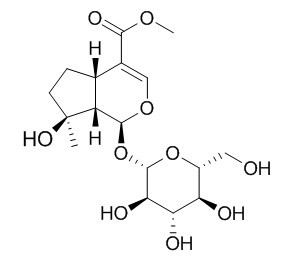Mussaenoside
Mussaenoside has anti-inflammatory action, the mechanism associated with downregulation of nuclear factor-κB. Mussaenoside can inhibit the release of pro-inflammatory cytokines induced by LPS, the production of nitric oxide (NO) and prostaglandin E2, and the expression of inducible NO synthase and cyclooxygenase-2 induced by lipopolysaccharide (LPS) in the RAW264.7 murine macrophage cell line.
Inquire / Order:
manager@chemfaces.com
Technical Inquiries:
service@chemfaces.com
Tel:
+86-27-84237783
Fax:
+86-27-84254680
Address:
1 Building, No. 83, CheCheng Rd., Wuhan Economic and Technological Development Zone, Wuhan, Hubei 430056, PRC
Providing storage is as stated on the product vial and the vial is kept tightly sealed, the product can be stored for up to
24 months(2-8C).
Wherever possible, you should prepare and use solutions on the same day. However, if you need to make up stock solutions in advance, we recommend that you store the solution as aliquots in tightly sealed vials at -20C. Generally, these will be useable for up to two weeks. Before use, and prior to opening the vial we recommend that you allow your product to equilibrate to room temperature for at least 1 hour.
Need more advice on solubility, usage and handling? Please email to: service@chemfaces.com
The packaging of the product may have turned upside down during transportation, resulting in the natural compounds adhering to the neck or cap of the vial. take the vial out of its packaging and gently shake to let the compounds fall to the bottom of the vial. for liquid products, centrifuge at 200-500 RPM to gather the liquid at the bottom of the vial. try to avoid loss or contamination during handling.
World J.Traditional Chinese Med.2024, 10(3):370-382
Plants (Basel).2024, 13(19):2793.
Antioxidants (Basel).2020, 9(2): E119
Toxicol Mech Methods.2021, 1-12.
Journal of Phytopathology2021, 169,Issue11-12.
Appl. Sci.2025, 15(1), 247
Pol J Microbiol.2021, 70(1):117-130.
Molecules.2021, 26(2):E255.
Nutrients.2019, 12(1)
Journal of Applied Pharmaceutical Science2022, 0(00), pp:001-007
Related and Featured Products
Molecules. 2013 Sep 30;18(10):12109-18.
Anti-inflammatory activity of iridoids and verbascoside isolated from Castilleja tenuiflora.[Pubmed:
24084016]
Castilleja tenuiflora (Orobanchaceae) has been used in Mexican traditional medicine as a treatment for cough, dysentery, anxiety, nausea and vomiting as well as hepatic and gastrointestinal diseases.
METHODS AND RESULTS:
The ethanolic extract of the aerial parts of Castilleja tenuiflora was separated by silica gel column chromatography. The fractions were evaluated using the induced edema acetate 12-O-tetradecanoylphorbol (TPA) anti-inflammatory activity model. The most active fraction was subjected to medium-pressure liquid chromatography (MPLC) with UV detection at 206 and 240 nm. The following iridoids were isolated: geniposidic acid, aucubin, bartioside, 8-epi-loganin, Mussaenoside, and the phenylpropanoid verbascoside. The most active iridoid was geniposidic acid, which was more active than the control (indomethacin), and the least active iridoid was Mussaenoside. 8-epi-Loganin, and Mussaenoside have not been previously reported to be anti-inflammatory compounds.
CONCLUSIONS:
The results of these investigations confirm the potential of Mexican plants for the production of bioactive compounds and validate the ethnomedical use of Castilleja tenuiflora-like anti-inflammatory plants.
Evid Based Complement Alternat Med. 2013;2013:395316.
The Herbal Drug Melampyrum pratense L. (Koch): Isolation and Identification of Its Bioactive Compounds Targeting Mediators of Inflammation.[Pubmed:
23533479]
Melampyrum pratense L. (Koch) is used in traditional Austrian medicine for the treatment of different inflammation-related conditions.
METHODS AND RESULTS:
In this work, we show that the extracts of M. pratense stimulated peroxisome proliferator-activated receptors- (PPARs-) α and - γ that are well recognized for their anti-inflammatory activities. Furthermore, the extract inhibited the activation of the proinflammatory transcription factor NF- κ B and induction of its target genes interleukin-8 (IL-8) and E-selectin in vitro. Bioassay-guided fractionation identified several active flavonoids and iridoids including melampyroside and Mussaenoside and the phenolic compound lunularin that were identified in this species for the first time. The flavonoids apigenin and luteolin were distinguished as the main components accountable for the anti-inflammatory properties. Apigenin and luteolin effectively inhibited tumor necrosis factor α (TNF- α )-induced NF- κ B-mediated transactivation of a luciferase reporter gene. Furthermore, the two compounds dose-dependently reduced IL-8 and E-selectin protein expression after stimulation with lipopolysaccharide (LPS) or TNF- α in endothelial cells (ECs). The iridoids melampyroside and Mussaenoside prevented the elevation of E-selectin in LPS-stimulated ECs. Lunularin was found to reduce the protein levels of the proinflammatory mediators E-selectin and IL-8 in ECs in response to LPS.
CONCLUSIONS:
These data validate the ethnomedical use of M. pratense for the treatment of inflammatory conditions and point to the constituents accountable for its anti-inflammatory activity.
Arch Pharm Res. 2014 Jul;37(7):947-54.
Secondary metabolites isolated from Castilleja rubra exert anti-inflammatory effects through NF-κB inactivation on lipopolysaccharide-induced RAW264.7 macrophages.[Pubmed:
24062082]
METHODS AND RESULTS:
8-Epiloganin (1), Mussaenoside (2), and 5-O-caffeoylshikimic acid (3) have been isolated from Castilleja rubra, and the anti-inflammatory properties of these metabolites in a cell culture system were investigated. Compounds 1-3 suppressed not only the production of nitric oxide (NO) and prostaglandin E2, but also the expression of inducible NO synthase and cyclooxygenase-2 induced by lipopolysaccharide (LPS) in the RAW264.7 murine macrophage cell line. Compounds 1-3 also inhibited the release of pro-inflammatory cytokines induced by LPS, namely, tumor necrosis factor-α and interleukin-1β.
CONCLUSIONS:
The underlying mechanism of the anti-inflammatory action of compounds 1-3 was associated with downregulation of nuclear factor-κB.



